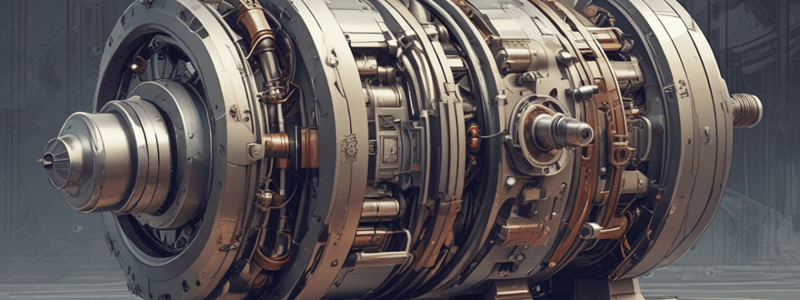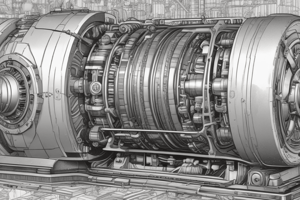Podcast
Questions and Answers
What is the primary function of the stator in a DC motor?
What is the primary function of the stator in a DC motor?
- Convert mechanical energy into electrical energy
- Rotate the armature
- Generate the magnetic field (correct)
- Act as the device's outer frame
Which component of the DC motor is responsible for converting electrical energy into mechanical energy?
Which component of the DC motor is responsible for converting electrical energy into mechanical energy?
- Carbon brushes
- Yoke
- Field coil
- Armature (correct)
What is the purpose of the commutator in a DC motor?
What is the purpose of the commutator in a DC motor?
- Generate the magnetic field
- Rotate the armature
- Strengthen the outer frame of the motor
- Switch the current direction in the armature coil (correct)
In a large DC motor, what is used instead of permanent magnets to create the stator's magnetic field?
In a large DC motor, what is used instead of permanent magnets to create the stator's magnetic field?
What is the role of the yoke in a DC motor's construction?
What is the role of the yoke in a DC motor's construction?
What is the characteristic of a DC series motor before magnetic saturation of the field?
What is the characteristic of a DC series motor before magnetic saturation of the field?
In a DC shunt motor, what is the relationship between armature torque and armature current?
In a DC shunt motor, what is the relationship between armature torque and armature current?
What is the primary reason a shunt motor should not be started on heavy loads based on the characteristics?
What is the primary reason a shunt motor should not be started on heavy loads based on the characteristics?
How is the field winding connected in a DC compound motor?
How is the field winding connected in a DC compound motor?
Why does the speed of a shunt motor slightly decrease when the load is increased?
Why does the speed of a shunt motor slightly decrease when the load is increased?
In a DC motor, the magnetic field is provided by:
In a DC motor, the magnetic field is provided by:
What is the purpose of the commutator in a DC motor?
What is the purpose of the commutator in a DC motor?
What causes the armature conductors to experience a force in a DC motor?
What causes the armature conductors to experience a force in a DC motor?
What is the function of the poles and pole shoe in a DC motor?
What is the function of the poles and pole shoe in a DC motor?
How is the speed of a DC series motor affected?
How is the speed of a DC series motor affected?
What is the general relationship between torque and armature current in DC series motors prior to magnetic saturation?
What is the general relationship between torque and armature current in DC series motors prior to magnetic saturation?
How does the speed of a DC series motor change with an increase in armature current?
How does the speed of a DC series motor change with an increase in armature current?
What happens to the speed versus armature current curve of a DC series motor after magnetic saturation is reached?
What happens to the speed versus armature current curve of a DC series motor after magnetic saturation is reached?
What is the primary principle on which the construction of a single-phase transformer is based?
What is the primary principle on which the construction of a single-phase transformer is based?
Which material is NOT commonly used in the construction of a transformer core?
Which material is NOT commonly used in the construction of a transformer core?
What is the purpose of the Buchholz relay in a single-phase transformer system?
What is the purpose of the Buchholz relay in a single-phase transformer system?
What causes the change in color of silica gel crystals used in a single-phase transformer breather?
What causes the change in color of silica gel crystals used in a single-phase transformer breather?
How does an on-load tap changer differ from an off-load tap changer in a single-phase transformer?
How does an on-load tap changer differ from an off-load tap changer in a single-phase transformer?
What is the role of the explosion vent in a single-phase transformer?
What is the role of the explosion vent in a single-phase transformer?
What is the purpose of the no-load current in a single-phase transformer?
What is the purpose of the no-load current in a single-phase transformer?
What is the primary current I1’ called due to its phase opposition with the secondary current I2?
What is the primary current I1’ called due to its phase opposition with the secondary current I2?
What happens to the direction of the flux when the additional current I’1 is induced?
What happens to the direction of the flux when the additional current I’1 is induced?
What describes the power factor angle ?1 of the primary side of the transformer?
What describes the power factor angle ?1 of the primary side of the transformer?
What does the form factor of 1.11 for a sinusoidal waveform indicate?
What does the form factor of 1.11 for a sinusoidal waveform indicate?
What is the relationship between the RMS values of induced emf in the primary and secondary windings of a transformer?
What is the relationship between the RMS values of induced emf in the primary and secondary windings of a transformer?
Which material is recommended to minimize hysteresis loss in a transformer?
Which material is recommended to minimize hysteresis loss in a transformer?
What is the type of loss that can be minimized by constructing the core of a transformer with thin laminations?
What is the type of loss that can be minimized by constructing the core of a transformer with thin laminations?
What is the Power loss known as that is caused by the circulation of eddy currents in a transformer's core?
What is the Power loss known as that is caused by the circulation of eddy currents in a transformer's core?
What remains constant in a transformer from no-load to full load, leading to it being known as a constant loss?
What remains constant in a transformer from no-load to full load, leading to it being known as a constant loss?
What causes copper losses in a transformer?
What causes copper losses in a transformer?
Which type of loss in a transformer is influenced by the load and hence called variable loss?
Which type of loss in a transformer is influenced by the load and hence called variable loss?
What is the formula to calculate the hysteresis loss in a transformer?
What is the formula to calculate the hysteresis loss in a transformer?
Which loss in a transformer arises due to the alternating nature of the flux in the core, leading to eddy currents and subsequent energy dissipation?
Which loss in a transformer arises due to the alternating nature of the flux in the core, leading to eddy currents and subsequent energy dissipation?
What is the reason for using thin laminations in the core of a transformer?
What is the reason for using thin laminations in the core of a transformer?
How do copper losses vary in a transformer as compared to iron losses?
How do copper losses vary in a transformer as compared to iron losses?
Flashcards are hidden until you start studying





